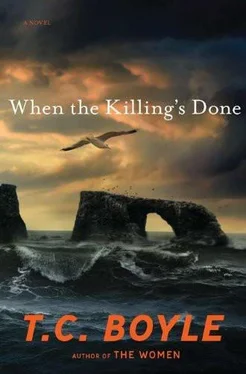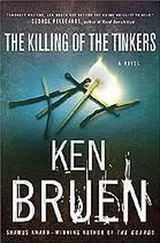After a moment, Wilson says, “Yeah, but I still don’t like it if I can’t see where I’m going.”
“You don’t have to.”
“This is what I like, this kind of chart here”—he leans forward to pull one of the laminated sheets out of the rack to his left. “Old school, you know what I mean? Something you can hold on to. But what’s this yellow thing here in the middle?”
“What, you need glasses now?”
Wilson squints, holds the chart out at arm’s length. “Only when I’m on the job,” he says. “But I can make it out: ‘East Santa Barbara Channel Weather Buoy.’ But you already knew that.”
“We just passed it. We’re like halfway to the island, then we’ve another bit to get around the west side and all the way out to Coches.”
“So we’re in the”—quoting—“ ‘Northbound Coastwise Shipping Lane’?”
“No, see here, on the GPS — we just left it. We’re in the zone in between.”
“The Separation Zone.”
“Right. And once we cross the southbound lane, in about five minutes, we’re home free. Until we get to the western tip of the island and head into the Santa Cruz Channel, which is where the rocks are, since you’re asking. So no beer, no cocktails, nothing, not for me. Not till we drop anchor and I can relax, because you know as well as I, you don’t want to fuck around out here. Especially in conditions like this.”
“I hear you. But your copilot, he can drink himself into a coma — in fact, isn’t that required, I mean, by regulation? Unless you have a heart attack. You’re not going to have a heart attack on us, are you, Dave?”
The wash of the waves, the stray giggle from below. No birds, not even shearwaters. The strained half-light of the sun up there somewhere trying to break through. And the calm. The calm you can’t buy. Or maybe you can, because isn’t that what they’re doing?
“You know something I didn’t tell you — or Alicia or Anise even?”
Grinning now, leaning over his knees, the hat pushed up high on his crown with a quick nervous flick of his fingers, Wilson awaits the answer. He likes surprises, likes parties. “What?” he says and the grin expands.
“It’s not just rabbits we’re setting loose today. You know that guy from Texas, the one your friend or uncle or whoever knows? The snake man?”
“Get out of here.”
“Yeah, we’ve got ten primo condition rattlesnakes down there in the hold in burlap sacks. And that’s just the start — guy says he can get as many as we want.”
“Can I see them?”
“Not till we get there.”
“Aw, come on, what are you afraid of? The Sequel: Snakes on a Boat. I can see it now. Come on, man, I used to handle snakes when I was kid. I had like six terrariums, with a rubber boa, a racer, couple of gopher snakes, kings and rattlers, rattlers too. Did you know that the ones in the San Gabriels, down in L.A., are going through a whole weird evolutionary change where the snakes with the smallest rattles get to mate more because the big ones, the noisy old pissed-off cascabeles , are all getting killed off?”
“I don’t know. I wouldn’t doubt it. But these ones are going to be just fine.” And this is his vision — he can see it right there before him — coming to fruition, because the snakes he’s bringing out here where nobody’s going to bother them can grow till their rattles drop off, and if that isn’t conservation, he doesn’t know what is.
“Come on. Just one. Just let me see one.” Wilson’s eyes — he’s never noticed this before — palpitate ever so slightly, nerves jumping under the whites like the snakes moving silently in the loose grip of their bags.
“I said no. Can you hear me? Am I talking loud enough for you?”
Wilson’s shoulders go tight and his mouth draws down. He smoothes his goatee a moment, as if thinking things through, then pushes himself up from the bench, jamming the chart back in its rack and swiping up the empty bottle in the same motion. “All right, fuck it. But I’m going down there — to get a beer — and if I happen to take a look then that’s my business, right?” And then he turns, puts both hands on the rails and disappears down the steps.
He’s calm. He’s been calm all day, all week. But this just turns his burners on high because Wilson can be such a jerk sometimes, and what is he anyway but just a carpenter and a wiseass who thinks he can rain on anybody anytime he wants, and before he can stop himself Dave is up from the controls and hammering down the steps shouting, “No, you’re wrong — it’s my fucking boat and it’s my fucking business!”
The Tokachi-maru , a twelve-thousand-ton freighter out of Nagoya, bound for Long Beach with a load of Chinese-made textiles and machine parts, was one of the oldest ships still flying a Japanese flag. She’d been commissioned in the late 1960s and except for brief spells in port or dry dock had been at sea continuously ever since. She was etched with rust from the waterline all the way up her six decks to the bridge, and though paint had been applied belowdecks and above in various eras (elephant-gray and dirt-adherent white for the most part), she tended to stand out in any harbor as an eyesore, if not a derelict. Still, she was a moneymaker for her owners, who intended to sail her until it was no longer economically feasible — or better yet, till she went to the bottom in some fortuitous South Sea typhoon, fully insured, of course, and with all hands spared. There had been surprisingly few accidents aboard, given the miles she’d logged and the years she’d been at sea (the usual broken bones, heart attacks and cases of alcohol poisoning, and just one man overboard, off the coast of Georgia in the late 1980s, who was, regrettably, never found), but for all her unsightliness and the problems the crew had with doors that rusted shut and the galley that still relied on the original four-burner gas range and three antiquated microwave ovens, her instruments were state of the art and her captain, Noboru Nishizawa, nephew of the ship’s first commander, was among the most reliable and cautious in the entire fleet.
On this particular day, a Saturday in June, the ship encountered dense fog on entering the Santa Barbara Channel from the north and Captain Nishizawa himself appeared on the bridge to oversee operations. As a precaution he cut the engines to three-quarter speed and ordered the ship’s horn to sound at intervals. Beyond that, he relied on his instruments, his experience and the sheer mass of the ship to keep them from harm. He was right dead center in the middle of the southbound lane and nothing was showing on the radar up ahead of him. If there was an emergency, the Tokachi-maru would take two miles and three and a half minutes to come to a stop. The tightest turn of which she was capable was nearly a mile across. And at seven stories above the surface, even in the clearest conditions, the crew on the bridge would have little chance of sighting any small craft below in any case.
That was the way it was. That was what the shipping lanes — and the Separation Zone — were meant for. Was the system perfect? Of course not. The Separation Zone functioned like the median on a freeway, but there were no lines drawn on the water to delineate the lanes and no concrete bumpers, palms or oleanders to separate north- and southbound traffic. Were there accidents? Of course there were. But in most cases the crew of a freighter or tanker never saw, felt or heard a thing when a small craft was unlucky enough to blunder across its path. Think of it this way: a heavyset woman, heavier even than Marta at the Cactus Café, a real monument of flesh and bone and live working juices, plods out to her car on aching feet after a double shift and can’t begin to know the devastation she wreaks on the world of the ant, the beetle and the grub.
Читать дальше












